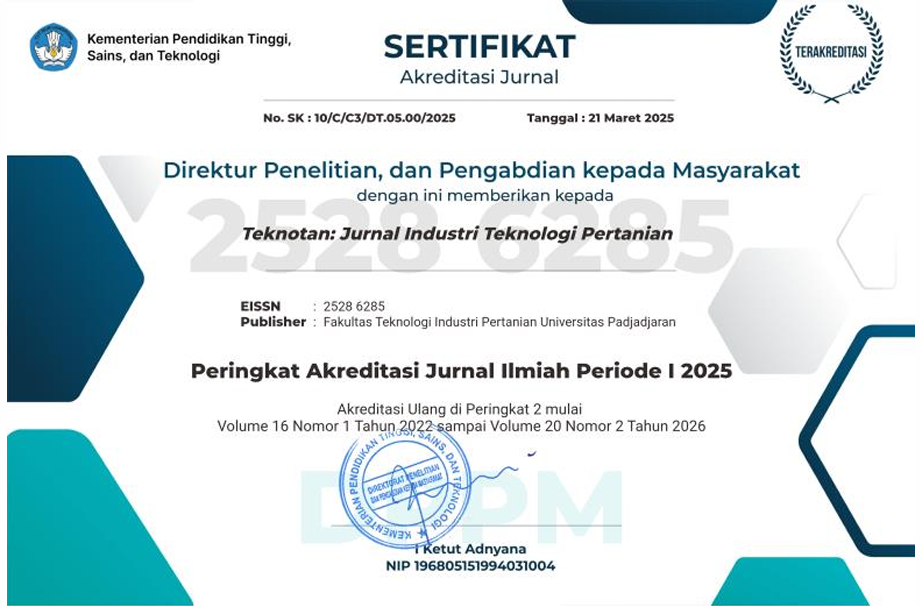Pembuatan Kemasan Biokomposit Berbasis PVA (Polyvinyl Alcohol) dan Limbah Kulit Kopi
Abstract
Kemasan biokomposit adalah kemasan yang dibuat dari campuran dari beberapa bahan alam. Dalam makalah ini dipaparkan hasil penelitian kemasan biokomposit yang menggunakan campuran kulit luar biji kopi dengan polimer alam polivinil alkohol (PVA) yang berasal dari sintesis bakteri. Kulit luar kopi merupakan limbah dari industri pengolahan kopi yang terdiri dari campuran kulit luar dan kulit tipis (silver skin) yang terlepas pada saat proses pembersihan. Kulit luar kopi mengandung kandungan serat selulosa yang dapat menjadi bahan pengisi dalam pembuatan kemasan biokomposit berbasis PVA. Polivinil alkohol (PVA) memiliki kekuatan tarik yang baik sehingga sering dimanfaatkan dalam pembuatan kemasan, meskipun demikian PVA memiliki kelemahan yaitu mudah menyerap air sehingga mudah terurai ketika kontak dengan air. Dalam penelitian ini, kulit luar kopi ditambahkan sebagai material pengisi untuk meningkatkan sifat fisik dan mekanik komposit berbasis PVA komersial supaya lebih tahan air, tidak mudah terurai, dan aman bagi lingkungan. Yang menjadi faktor dalam penelitian ini adalah rasio perlakuan PVA dan limbah kopi (100:0, 90:10, 80:20, 70:30, 60:40, 50:50) serta penambahan plasticizer gliserol dengan konsentrasi yang berbeda (2% dan 4%) campuran kemudian dicampur dan dipanaskan sebelum dicetak dengan menggunakan aplikator. Pada tahap berikutnya dilakukan penambahan asam sitrat untuk meningkatkan ketahanan air dari kemasan biokomposit. Penambahan kulit luar kopi dapat meningkatkan karakteristik mekanik kemasan biokomposit berbasis PVA (rasio 90:10) dengan penambahan gliserol dan asam sitrat sebanyak 2%. Biokomposit yang dihasilkan memiliki penurunan daya serap air sebanyak sebanyak 70% dan waktu urai 2 kali lebih panjang dibanding kontrol kemasan dengan menggunakan 100% PVA. Selain itu juga memiliki tekstur yang baik, dengan nilai kuat tarik sebesar 12,48±1,60 MPa, elongasi sebesar 301,99±32,18%, dan modulus Young sebesar 4,16±0,08 MPa.
Keywords
Full Text:
PDF (Bahasa Indonesia)References
Abdulkhani, A., Marvast, E., Ashori, A., Hamzeh, Y., & Karimi, A. (2013). Preparation of cellulose/polyvinyl alcohol biocomposite films using 1-n-butyl-3-methylimidazolium chloride. International Journal of Biological Macromolecules, 62. doi: 10.1016/j.ijbiomac.2013.08.050
Badan Pusat Statistik. (2023). Statistik Kopi Indonesia 2021. In Badan Pusat Statistik. Jakarta. Retrieved from https://www.bps.go.id/id/publication/2023/11/30/abde293e6c0fc5d45aaa9fe8/statistik-kopi-indonesia-2022.html
Buxoo, S., & Jeetah, P. (2020). Feasibility of producing biodegradable disposable paper cup from pineapple peels, orange peels and Mauritian hemp leaves with beeswax coating. SN Applied Sciences, 2(8), 1359. doi: 10.1007/s42452-020-3164-7
Czibulya, Z., Csík, A., Tóth, F., Pál, P., Csarnovics, I., Zelkó, R., & Hegedűs, C. (2021). The Effect of the PVA/Chitosan/Citric Acid Ratio on the Hydrophilicity of Electrospun Nanofiber Meshes. Polymers, 13(20). doi: 10.3390/polym13203557
Frone, A., Panaitescu, D., Donescu, D., Spataru, C., Radovici, C., Trusca, R., & Somoghi, R. (2011). Preparation and characterization of PVA composites with cellulose nanofibers obtained by ultrasonication. Bioresources, 6, 487. doi: 10.15376/biores.6.1.487-512
Galus, S., & Kadzińska, J. (2016). Moisture Sensitivity, Optical, Mechanical and Structural Properties of Whey Protein-Based Edible Films Incorporated with Rapeseed Oil. Food Technology and Biotechnology, 54(1), 78–89. doi: 10.17113/ftb.54.01.16.3889
Garcia, C. V, & Kim, Y.-T. (2021). Spent Coffee Grounds and Coffee Silverskin as Potential Materials for Packaging: A Review. Journal of Polymers and the Environment, 29(8), 2372–2384. doi: 10.1007/s10924-021-02067-9
Hardjono, H., hermien suharti, P., Permatasari, D., & Sari, V. (2016). PENGARUH PENAMBAHAN ASAM SITRAT TERHADAP KARAKTERISTIK FILM PLASTIK BIODEGRADABLE DARI PATI KULIT PISANG KEPOK (Musa acuminata balbisiana Colla). Jurnal Bahan Alam Terbarukan, 5, 22–28. doi: 10.15294/jbat.v5i1.5965
Huang, S.-M., Liu, S.-M., Tseng, H.-Y., & Chen, W.-C. (2023). Effect of Citric Acid on Swelling Resistance and Physicochemical Properties of Post-Crosslinked Electrospun Polyvinyl Alcohol Fibrous Membrane. Polymers, 15(7). doi: 10.3390/polym15071738
Jiang, S., Qiao, C., Liu, R., Liu, Q., Xu, J., & Yao, J. (2023). Structure and properties of citric acid cross-linked chitosan/poly(vinyl alcohol) composite films for food packaging applications. Carbohydrate Polymers, 312, 120842. doi: https://doi.org/10.1016/j.carbpol.2023.120842
Lewandowska, K. (2009). Miscibility and thermal stability of poly(vinyl alcohol)/chitosan mixtures. Thermochimica Acta, 493(1), 42–48. doi: https://doi.org/10.1016/j.tca.2009.04.003
Limantara, J., Tedjokoesoemo, P. E. D., Rizqy, M. T., Studi, P., Interior, D., Petra, U. K., … Penelitian, A. M. (2019). Penggunaan Ampas Kopi Sebagai Material Alternatif pada Produk Interior. 7(2), 846–849.
Limbong, S. F., Harsojuwono, B. A., & Hartiati, A. (2022). Pengaruh Pengaruh Konsentrasi Polivinil Alkohol dan Lama Pengadukan pada Proses Pemanasan Terhadap Karakteristik Komposit Biotermoplastik Maizena dan Glukomanan. Jurnal Ilmiah Teknologi Pertanian Agrotechno; Vol 7 No 1 (2022)DO - 10.24843/JITPA.2022.V07.I01.P05 .
Mahardika, M., Asrofi, M., Amelia, D., Syafri, E., M R, S., & Siengchin, S. (2021). Tensile Strength and Moisture Resistance Properties of Biocomposite Films Based on Polyvinyl Alcohol (PVA) with Cellulose as Reinforcement from Durian Peel Fibers. E3S Web of Conferences, 302, 2001. doi: 10.1051/e3sconf/202130202001
Nataraj, D., Reddy, R., & Reddy, N. (2020). Crosslinking electrospun poly (vinyl) alcohol fibers with citric acid to impart aqueous stability for medical applications. European Polymer Journal, 124, 109484. doi: https://doi.org/10.1016/j.eurpolymj.2020.109484
Oliveira, G., Passos, C. P., Ferreira, P., Coimbra, M. A., & Gonçalves, I. (2021). Coffee By-Products and Their Suitability for Developing Active Food Packaging Materials. Foods, 10(3). doi: 10.3390/foods10030683
Ounkaew, A., Kasemsiri, P., Kamwilaisak, K., Saengprachatanarug, K., Mongkolthanaruk, W., Souvanh, M., … Chindaprasirt, P. (2018). Polyvinyl Alcohol (PVA)/Starch Bioactive Packaging Film Enriched with Antioxidants from Spent Coffee Ground and Citric Acid. Journal of Polymers and the Environment, 26(9), 3762–3772. doi: 10.1007/s10924-018-1254-z
Purnavita, S., & Anggraeni, A. (2019). Pengaruh Penambahan Beeswax Dan Gliserol Terhadap Karakteristik Poliblend Glukomanan – Polivinil Alkohol (Pva). Jurnal Inovasi Teknik Kimia, 4. doi: 10.31942/inteka.v4i2.3023
Santi, R., Cigada, A., Del Curto, B., & Farè, S. (2019). Modulable properties of PVA/cellulose fiber composites. Journal of Applied Biomaterials & Functional Materials, 17(1), 2280800019831224. doi: 10.1177/2280800019831224
Seligra, P. G., Medina Jaramillo, C., Famá, L., & Goyanes, S. (2016). Biodegradable and non-retrogradable eco-films based on starch-glycerol with citric acid as crosslinking agent. Carbohydrate Polymers, 138, 66–74. doi: 10.1016/j.carbpol.2015.11.041
Sharmin, N., Sone, I., Walsh, J. L., Sivertsvik, M., & Fernández, E. N. (2021). Effect of citric acid and plasma activated water on the functional properties of sodium alginate for potential food packaging applications. Food Packaging and Shelf Life, 29, 100733. doi: https://doi.org/10.1016/j.fpsl.2021.100733
DOI: https://doi.org/10.24198/jtvol17n3.10
Refbacks
- There are currently no refbacks.
Indexed by:

This work is licensed under a Creative Commons Attribution 4.0 International License (CC BY-SA 4.0)


1.png)
.png)







